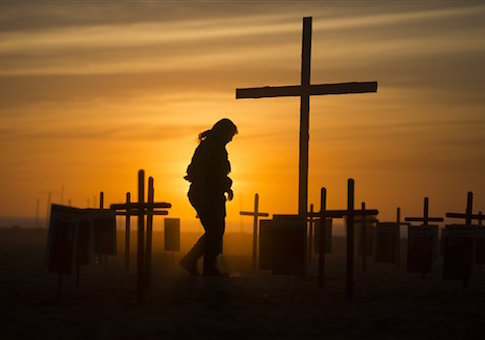"In communities scarred by violence, many don’t know what peace looks like. Teenagers in Brazilian favelas, Jamaican garrisons, and Honduran slums see these crime wars as a natural state of affairs. It’s normal to have men on the corner with Kalashnikovs, shots ringing out at night, corpses hanging from bridges.’’
Ioan Grillo’s new book shines a torch on the darker side of Latin America and the Caribbean—specifically, on the grotesque institutional violence used by criminal gangs. Grillo begins his journey in the slum cities of Rio de Janeiro. This is dangerous work. In 2001, a Brazilian investigative journalist attracted the ire of a gang and was subjected to a street trial. Finding him guilty, the gang "burned his eyes with cigarettes, used a samurai sword to cut off his arms and legs while he was still alive, put his body in a tire with gasoline and set him on fire.’’ The gangs call this "the microonda, or microwave oven.’’
In Brazil, Grillo charts the history of the Red Commando gangsters. A fusion of leftist ideologues and street criminality, the Red Commando found its roots in a traditionalist Latin American leftist guerilla movement. Yet while Grillo documents the extensive claims made by a senior Red Commando leader that the organization is a political movement, it quickly becomes clear that political ideology has been forgotten in favor of profit.
Justice systems in Latin America have been unable to cope with a rising tide of crime, largely due to the failure of correctional institutions, a "paradox of Latin America’s crime wars. Prisons are meant to stop gangsters from committing crimes. But they became their headquarters.’’ Unable or unwilling to control the activities of senior gangsters behind bars, the authorities have allowed those gangsters to establish the means of maintaining order there. In doing so, they have accepted the gangsters’ role and power in society.
Jumping to Jamaica, we read of Christopher Coke, aka ‘Dudus’ or ‘the President.’ In the course of an interesting look at the interaction between organized crime and political patronage, a troubling element of Grillo’s reporting pops up: his odd entertainment of spurious stories that implicate the CIA in Jamaica’s violence. Shortly thereafter he also claims that the UK’s counter-gang crime unit in London is heavy handed and counter-productive. Ultimately, Dudus was only taken off the streets by the concerted political and judicial pressure from the US government: a good thing! Grillo describes some of Dudus’s day-to-day activities, like machete-ing a mentally ill man to death.
Moving on from Jamaica, Grillo takes us inside the gang warfare of Honduras and Mexico, where the crazed level of violence has essentially rendered police forces irrelevant. The author also points out why gang violence has been harder to restrain in Central America. "In the robust United States, gangs were largely contained in ghetto areas and the death toll was limited. But in weakened Central America, they rapidly overwhelmed police.’’ We see how for many young men, the absence of economic opportunity and the abundant control of gangs over neighborhoods means that the path into gangs is far easier, far more rewarding and far—at least in the short term—less risky than lawful employment.
Off to Mexico, we see how the political culture of our closest neighbor has become defined by Mexican society’s war with gangs. While Grillo takes us inside the specific efforts to confront these gangs by the current and previous two Mexican presidents—and how the gangs responded—his most interesting reporting concerns his description of the vigilante groups now opposing the criminals. He explains how the vigilante movement rose when the gangs started to pose an existential threat. "As Templar thugs collected extortion payments they would abduct the wives or daughters of residents. They would also hang around outside schools, checking out the girls they wanted to rape … the youngest was just eleven years old.’’
Gangster Warlords makes for important, if unsettling, reading. Grillo has taken immense risks and completed a very well sourced book. Yet his conclusions are unpersuasive, and hobbled by unhelpful ideological commitments. Skeptical of the U.S. government and its counter-narcotics efforts, and absorbed by the suffering that the warlords have imposed, he too-often hints at the idea of a compromise with devils.
